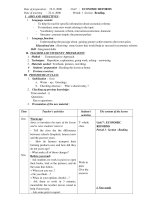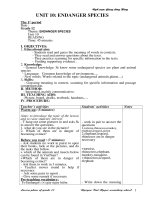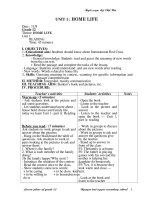Gián án English 12- unit 11- reading
Bạn đang xem bản rút gọn của tài liệu. Xem và tải ngay bản đầy đủ của tài liệu tại đây (1.48 MB, 17 trang )
What kind of are these books?
Novel
craft book
Comic book
Romance
Biography
Science book
Fiction
Thriller
Unit 11: Books – Reading
1. Taste (v)
2. Chew (v)
3. Swallow (v)
4. dip into (v)
5. Digest (v)
6. In a word
7. Reviewer (n)
8.Hard to put down
9. Hard to pick up again
- NÕm, thử, c lt
-
Nhai, nghin ngm
- Nuốt
Xem lt qua
Tiêu hoá, c v suy ngm
- Túm li
- Nhà phê bình
khụng th b xuống
- không thể đọc lần nữa
Unit 11: Books – Reading
Task 1: Match the words/phrases in A
with the Vietnamese equivalent in B
A
B
1. Taste
2. Chew
3. Swallow
4. dip into
5. Digest
6. “Hard - to - pick - up
again”
7. “Hard - to - put - down
a. Đọc thử, đọc lướt qua
b. Không thể đọc lại lần nữa
c. Đọc và suy ngẫm
d. Nghiền ngẫm
e. Đọc ngấu nghin
f. Đọc qua loa
g. Không thể đặt xuống
Task 2: Decide whether the following statements are true
(T), false (F) or not mentioned (NM) in the reading
passage
1. You can’t read different types of
books in the same way
2. When you “taste” a book you read it
carefully from the beginning to the end
3. Many people only have time to read
when they are traveling
4. Books with good stories are often
described as “ hard-to-put-down”.
5. Television has replaced books
altogether.
NM
F
NM
T
F
Task 3: Answer these questions according to the
information in the passage.
1. How many ways of reading are there?
2. When do you “swallow” a book?
3. What should you do before starting to read a
book carefully and slowly?
4. What are the advantages of television over
books?
5. What are the advantages of books over
television?
Paragraph 1
On the subject of reading, 1. How many ways of
Francis Bacon, who lived at about reading are there?
the same time as Shakespeare, wrote
these words, "Some books are to be There are three.
tasted, others to be swallowed, and
some few to be chewed and
digested." This good advice shows
how it is possible to read different
types of books in different ways. For
example, you might pick up a travel
book and read a few pages before
going to sleep. It is enough to dip
into it and read bits here and there.
In a word, this is "tasting" .
Paragraph 2
Some stories are for "
2.When do you “swallow” a
swallowing ". Imagine that you
book?
have found a good story, and,
When you find a good
what is even more important,
story and have time to
the time to enjoy it. You might
be on holiday, or on a long train
enjoy it.
journey. If it is a good book, you
might say, "It's so good i can't
put it down ". But not all stories
belong to this class. Reviewers
sometimes describe books as
"hard-to-put-down", or "hardto-pick-up-again".
Paragraph 3
Other books are for reading
slowly and carefully. If it is a
book on a subject that you
are interested in, you will
want to "chew and digest it".
That does not mean reading
it too slowly. When you pick
up a book for the first time,
check that it is not too
difficult. Do not start a book
unless you can see from the
first few pages that it is one
you can easily read and
understand.
3. What should you do
before starting to read a
book
carefully
and
slowly ?
Read a few pages to see
if it’s the one you can
read and understand it
easily.
Paragraph 4
Some people think that as
more and more people have television
in their homes, fewer people will buy
books to read. Why read when
television can bring you all the
information and stories with colour,
picture and action? But, in fact,
television has not killed reading.
Today, more books of every kind are
sold than ever before. Books are still
a cheap way to get information and
entertainment, and you can keep a
book forever and read it many times.
Books in the home are wonderful
source of knowledge and pleasure.
4. What are the advantages
of television over books?
Television can bring you
all the information and
stories with colour,
Pictures and action.
5. What are the advantages
of books over television?
Books are still a cheap
way to get information
and entertainment.
(And you can keep a
book forever and read
it at many times).
Work in pairs or groups. Find the names of types of books in
the square. The words may go across, down, up, backwards,
or an angle. Here are some cues.
A
A
B
H
F
L
E
S
C
I
E
N
C
E
L
E
V
O
N
R
B
F
B
J
A
M
X
Z
K
I
M
J
T
W
C
G
O
C
B
H
S
T
R
G
R
T
R
Q
E
V
R
A
J
I
C
A
C
A
F
V
L
O
J
W
P
T
Q
L
M
M
S
H
S
W
E
I
F
G
Y
W
R
R
C
V
D
R
T
K
Y
F
U
a. c........... books a type ofto work by a book, is should
h. If you want to learnatell an exciting affairs,especially one
e. A n...... is a isreading how stories fill aauthor’swood, .imagined
d. If you like books stories from love story imagination.
c. As..............fiction isstories aboutthrough pictures in which
b. A b........... story long enough lifethethatwithsomebody the
enjoy about person’s book complete r.......
g.
f. F...............books tellwithto knit orwrittenis based onyouelse.
about crime or spy, read t..........
buy charactersyou. events areausually imaginary.
scientific discoveries
the a c....... book.
right book for and of the future.
A
A
B
H
F
L
E
S
C
I
E
N
C
E
L
E
V
O
N
R
B
F
B
J
A
M
X
Z
K
I
M
J
T
W
C
G
O
C
B
H
S
T
R
G
R
T
R
Q
E
V
R
A
J
I
C
A
C
A
F
V
L
O
J
W
P
T
Q
L
M
N
S
H
S
W
E
I
F
G
Y
W
R
R
C
V
D
R
T
K
Y
F
U
Unit 11: Books – Reading
-
Learn by heart vocabulary
-Prepare the next lesson









